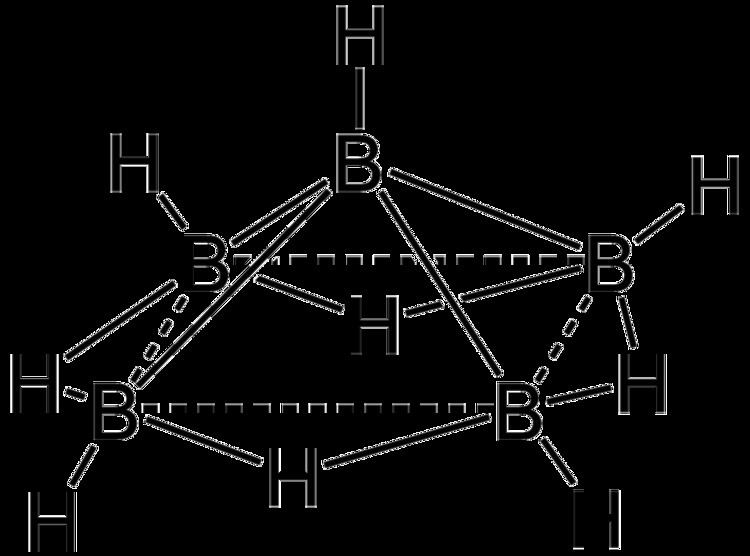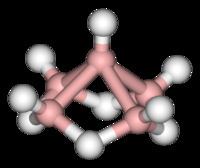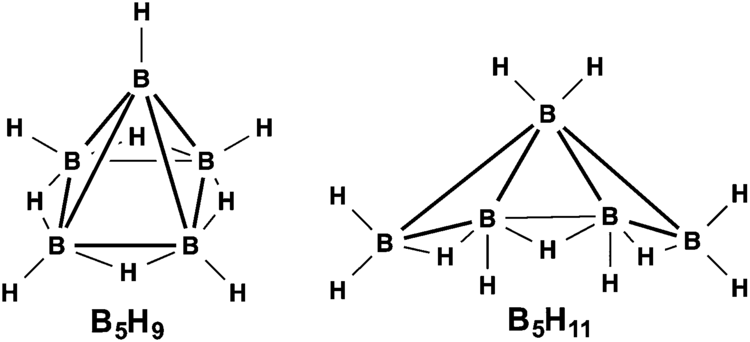Appearance Colorless liquid Molar mass 63.12 g/mol Boiling point 60.1 °C | Formula B5H9 Density 618 kg/m³ Melting point -46.8 °C | |
 | ||
Pentaborane, also called pentaborane(9) to distinguish it from pentaborane(11) (B5H11), is an inorganic compound with the formula B5H9. It is one of the most common boron hydride clusters, although it is a highly reactive compound. Because of its high reactivity toward oxygen, it was once evaluated as rocket or jet fuel. Like many of the smaller boron hydrides, pentaborane is colourless, diamagnetic, and volatile.
Contents

Structure, synthesis, properties

Its structure is that of five atoms of boron arranged in a square pyramid. Each boron has a terminal hydride ligand and four hydrides span the edges of the base of the pyramid. It is classified as a nido cage.
It was first prepared by Alfred Stock by pyrolysis of diborane at about 200 °C. An improved synthesis starts from salts of B3H8−, which is converted to the bromide B3H7Br− using is HBr. Pyrolysis of this bromide gives pentaborane.
5 B3H7Br− → 3 B5H9 + 5 Br− + 4 H2In the U.S., pentaborane was produced on a commercial scale by Callery Chemical Company.

Above 150 °C, it decomposes, producing hydrogen; when it occurs in a closed container, the consequent rise of pressure can be dangerous. It is much more stable in presence of water than diborane. It is soluble in hydrocarbons, benzene, and cyclohexane, and in greases including those used in lab equipment. In storage, it decomposes negligibly, yielding a small amount of hydrogen and solid residue.
Reactions
The chemistry of pentaborane is extensive. Halogenation give the symmetrical derivatives B5H8X, which can be isomerised to place the halide on the base of the square pyramid. With strong bases such as alkyl lithium reagents, it can be deprotonated and the resulting lithium salts react with diverse electrophiles to give substituted derivatives. It is Lewis acidic, forming double adducts with two equivalents of trimethylphosphine. Pentaborane is used for the synthesis of other boron hydride clusters.
History of its use as a fuel
Pentaborane was evaluated by both the U.S. and Russian armed services as a so-called "exotic fuel". Because simple boron compounds burn with a characteristic green flame, the nickname for this fuel in the U.S. industry was "Green Dragon". In terms of heat of combustion, pentaborane surpasses its equivalent carbon compounds because their self-linking element, carbon, weighs more than one atomic mass unit more than an atom of boron, and some boranes contain more hydrogen than the carbon equivalent. The ease of breaking the chemical bonds of the compound is also taken into consideration.
Interest in this substance began as a possible fuel for high-speed jets. The propellant mix that would produce the greatest specific impulse for a rocket motor is sometimes given as oxygen difluoride and pentaborane. During the early years of the space race and the missile gap, American rocket engineers thought they could more cheaply produce a rocket that would compete with the Soviets by using an existing first stage and putting an upper stage with an engine that produces thrust at a very high specific impulse atop it. So projects were begun to investigate this fuel.
This pentaborane was considered for use as a fuel by North American Aviation when the XB-70 Valkyrie was in the planning stages, but the aircraft ended up using hydrocarbon fuel instead. Pentaborane was also investigated to be used as a bipropellant with nitrogen tetroxide. In the Soviet Union, Valentin Glushko used it for the experimental RD-270M rocket engine, under development between 1962 and 1970.
Other boranes were evaluated as fuels, including propylpentaborane (BEF-2) and ethyldecaborane (REF-3). Diborane and decaborane and their derivates were also investigated.
Problems with this fuel include its toxicity and its characteristic of bursting into flame on contact with the air. Furthermore, its exhaust (when used in a jet engine) would also be toxic. Long after the pentaborane was considered unworkable, the total United States stock of the chemical, 1900 pounds, was destroyed in the year 2000, when a safe and inexpensive means for doing so was finally engineered. The process used hydrolysis with steam, yielding hydrogen and a boric acid solution. The system was nicknamed "Dragon Slayer".
Safety
Above 30 °C it can form explosive concentration of vapors with air. Its vapors are heavier than air. It is pyrophoric—can ignite spontaneously in contact with air, when even slightly impure. It can also readily form shock sensitive explosive compounds, and reacts violently with some fire suppressants, notably with halocarbons and water. It is highly toxic and symptoms of lower-level exposure may occur with up to 48 hours delay. Its acute toxicity is comparable to some nerve agents.
Occupational exposure limits for pentaborane set by the Occupational Safety and Health Administration and National Institute for Occupational Safety and Health stand at 0.005 ppm (0.01 mg/m3) over an eight-hour time-weighted average, with a short-term exposure limit of 0.015 ppm (0.03 mg/m3). The acute toxicity of pentaborane has caused it to be considered immediately dangerous to life and health, with a limit set at 1 ppm.
